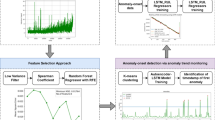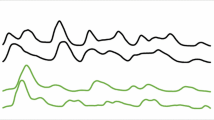Abstract
This paper presents a hybrid dynamic data-driven approach to achieve drift like fault detection of systems evolving in non-stationary environments. This approach considers the system switching between several control modes. This switching is entailed by changes in the system environments. In each control mode, the system has a different dynamical behavior. The latter is described in a feature space sensitive to normal operating conditions in the corresponding control mode. These operating conditions are represented by restricted zones in the feature space called classes. The latter are characterized by a set of parameters representing their statistical properties, e.g. gravity center and variance–covariance matrix. The occurrence of an incipient fault entails a drift in the system operating conditions until the failure takes over completely. This drift manifests as a progressive change in the classes parameters in each control mode over time. The proposed approach monitors normal classes’ parameters in order to detect a drift in their characteristics. This drift detection allows achieving the fault in its early stages. It uses two drift indicators. The first indicator detects the drift and the second indicator confirms it. Both indicators are based on the observation of changes in the normal operating conditions characteristics over time. A wind turbine simulator is used to validate the performance of the proposed approach.
























Similar content being viewed by others
References
Blesa J, Puig V, Romera J, Saludes J (2011) Fault diagnosis of wind turbines using a set-membership approach. In: Proceedings of IFAC world congress 18. Milan, Italy, pp 8316–8321
Chen W, Ding S, Sari A, Naik A, Khan A, Yin S (2011) Observer-based FDI schemes for wind turbine benchmark. In: Proceedings of IFAC world congress, 18. Milan, Italy, pp 7073–7078
Costa BSJ, Angelov PP, Guedes LA (2014) Real-time fault detection using recursive density estimation. In: Proceedings of control, automation and electrical systems 25:428–437
Kim K, Parthasarathy G, Uluyol O, Foslien W, Shuangwen S, Fleming P (2011) Use of SCADA Data for failure detection in wind turbines. In: Proceedings of the energy sustainability conference and fuel cell conference, Washington, USA, pp 1–9
Kolev D, Angelov P, Markarian G, Suvorov M, Lysanov S (2013) ARFA: automated real-time flight data analysis using evolving clustering, classifiers and recursive density estimation. In: Proceedings of evolving and adaptive intelligent systems, Singapore, pp 91–97
Kusiak A, Li W (2011) The prediction and diagnosis of wind turbine faults. Proc Renew Energy 36:16–23
Kusiak A,Verma A (2011) A data-driven approach for monitoring blade pitch faults in wind turbines. Sustain Energy pp 87–96
Laouti N, Sheibat-Othman N, Othman S (2011) Support vector machines for fault detection in wind turbines. In: Proceedings of IFAC world congress, 18. Milan, Italy, pp 7067–7072
Lecoeuche S, Lurette C (2003) Auto-adaptive and dynamical clustering neural network. In: Proceedings of ICANN’03. Istanbul, Turkey, pp 350–358
Liu W (1999) An extended Kalman filter and neural network cascade fault diagnosis strategy for the glutamic acid fermentation process. Artif Intell Eng 13:131–140
Nekoui MA, Kashanipour AR, Salahshoor K (2010) Hierarchical fault diagnosis using sensor data fusion for robotic system. In: Proceedings of electronics 14:55–60
Odgaard P, Stoustrup J (2009) Fault tolerant control of wind turbines: a benchmark model. In: Proceedings of the 7th IFAC symposium on fault detection, supervision and safety of technical processes. Sants Hotel, Spain, pp 155–160
Odgaard P, Stoustrup J (2010) Unknown input observer based detection of sensor faults in a wind turbine. In: Proceedings of control applications. Yokohama, Japan, pp 310–315
Odgaard P, Stoustrup J, Kinnaert M (2013) Fault tolerant control of wind turbines a benchmark model. Control Syst Technol 21:1168–1182
Ozdemir A, Seiler P, Balas G (2011) Wind turbine fault detection using counter-based residual thresholding. In: Proceedings of IFAC world congress, 18. Milan, Italy, pp 8289–8294
Rubio JJ (2014) Analytic neural network model of a wind turbine. In: Proceedings of soft computing, pp 1–9
Rubio JJ (2014b) Dynamic model of a wind turbine for the electric energy generation. Proc Math Probl Eng 2014:1–8
Schlechtingen M, Santos IF (2011) Comparative analysis of neural network and regression based condition monitoring approaches for wind turbine fault detection. Mech Syst Signal Process 25:1849–1875
Simani S, Castaldi P, Tilli A (2012) Data-driven modelling of a wind turbine benchmark for fault diagnosis application. Control Mech Syst 1:278–289
Toubakh H, Sayed-Mouchaweh M (2014) Advanced data mining approach for wind turbines fault prediction. In: Proceedings of second European conference of the prognostics and health management society 5. Nante, France, pp 288–296
Toubakh H, Sayed-Mouchaweh M, Duviella E (2013) Advanced pattern recognition approach for fault diagnosis of wind turbines. In: Proceedings of 12th ICMLA Miami, USA, pp 368–373
Traore M, Duviella E, Lecoeuche S (2009) Comparison of two prognosis methods based on neuro fuzzy inference system and clustering neural network. In: Proceedings of 7th IFAC symposium on fault detection, supervision and safety of technical processes. Sants Hotel, Spain, pp 1468–1473
Zhang X, Zhang Q, Zhao S, Ferrari RM, Polycarpou MM, Parisini T (2011) Fault detection and isolation of the wind turbine benchmark: an estimation-based approach. In: Proceedings of IFAC world congress, 18. Milan, Italy, pp 8295–8300
Acknowledgments
This work is supported by the region Nord Pas de Calais and Ecole des Mines de Douai.
Author information
Authors and Affiliations
Corresponding author
Rights and permissions
About this article
Cite this article
Toubakh, H., Sayed-Mouchaweh, M. Hybrid dynamic data-driven approach for drift-like fault detection in wind turbines. Evolving Systems 6, 115–129 (2015). https://doi.org/10.1007/s12530-014-9119-8
Received:
Accepted:
Published:
Issue Date:
DOI: https://doi.org/10.1007/s12530-014-9119-8




